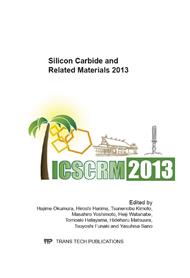p.1042
p.1046
p.1050
p.1054
p.1058
p.1063
p.1067
p.1071
p.1077
Discriminating High k Dielectric Gas Sensors
Abstract:
High temperature gas sensors for the detection of harmful gases under extreme conditions have been demonstrated. Here, we show the detection and selective response of two SiC based MIS sensor structures with HfO2 and TiO2 high κ dielectric layers to two different hydrogen containing gases. The structures utilise a Pt catalytic gate contact and a high-κ dielectric that was grown on a thin SiO2 layer, which was thermally grown on the Si face of epitaxial 4H SiC. The chemical characteristics of MIS capacitors have been studied in N2, O2, H2 and CH4 ambients at 573K. The data show a positive flatband voltage shift for oxygen and methane with respect to the nitrogen baseline, whilst hydrogen shows a negative shift. The response for the TiO2 based sensor is significantly larger than that of the HfO2 based device for hydrogen, enabling discrimination of gases within a mixture.
Info:
Periodical:
Pages:
1058-1062
Citation:
Online since:
February 2014
Keywords:
Price:
Сopyright:
© 2014 Trans Tech Publications Ltd. All Rights Reserved
Share:
Citation:


